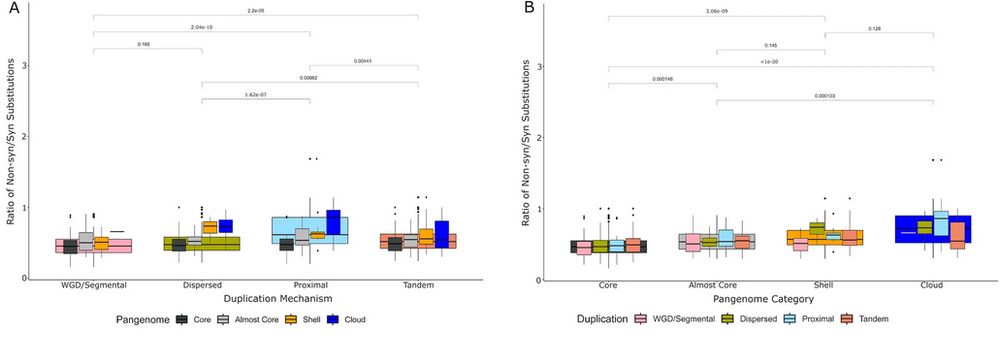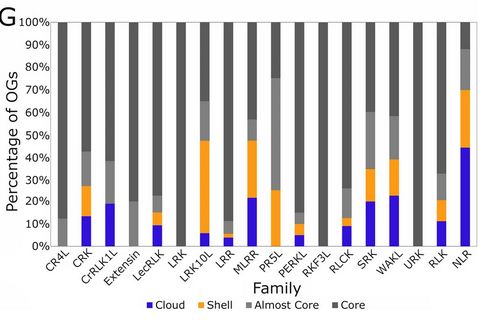
Adam Mott
@adammott.bsky.social
Scientist working on plant cell surface receptors and immune regulation using network and systems biology. Thoughts are my own.
We then observed that rather than whole subfamilies showing high rates of presence-absence variation, it tends to occur in clusters within subfamiles.

August 27, 2025 at 3:31 PM
We then observed that rather than whole subfamilies showing high rates of presence-absence variation, it tends to occur in clusters within subfamiles.
We next checked for positive selection and found that the number of non-synonymous substitutions scaled in a step-wise fashion based on pan-genome category, with core OGs showing the lowest and cloud OGs showing the highest amounts. High rates were also associated with OGs arising via TD and PD.

August 27, 2025 at 3:31 PM
We next checked for positive selection and found that the number of non-synonymous substitutions scaled in a step-wise fashion based on pan-genome category, with core OGs showing the lowest and cloud OGs showing the highest amounts. High rates were also associated with OGs arising via TD and PD.
We also examined the mechanism of duplication that is driving RLK expansion. Once again the NLRs show high rates of tandem or proximal duplication, but several subfamilies of RLKs show even higher proportions, notably the CRKs, MLRRs, and PR5Ls.

August 27, 2025 at 3:31 PM
We also examined the mechanism of duplication that is driving RLK expansion. Once again the NLRs show high rates of tandem or proximal duplication, but several subfamilies of RLKs show even higher proportions, notably the CRKs, MLRRs, and PR5Ls.
While most RLK orthogroups are present in the core or almost core collection, there are some subfamilies that show much higher proportions of OGs in the shell or cloud genomes. Compared to the intracellular NLRs, we found lower proportions in RLKs, though the MLRRs and LRK10Ls come close.

August 27, 2025 at 3:31 PM
While most RLK orthogroups are present in the core or almost core collection, there are some subfamilies that show much higher proportions of OGs in the shell or cloud genomes. Compared to the intracellular NLRs, we found lower proportions in RLKs, though the MLRRs and LRK10Ls come close.
We identified all the receptor-like kinase genes present in 146 long-read Arabidopsis genomes to compile a species-wide inventory, which saturated after ~10-25 ecotypes.

August 27, 2025 at 3:31 PM
We identified all the receptor-like kinase genes present in 146 long-read Arabidopsis genomes to compile a species-wide inventory, which saturated after ~10-25 ecotypes.
With everything else going on, it's reaffirming to see another group of amazing grads head out into the world

June 4, 2025 at 8:25 PM
With everything else going on, it's reaffirming to see another group of amazing grads head out into the world
I guess we'll give this a try, safely arrived at PAG32 in SD. Let the marathon begin...

January 10, 2025 at 6:21 PM
I guess we'll give this a try, safely arrived at PAG32 in SD. Let the marathon begin...

